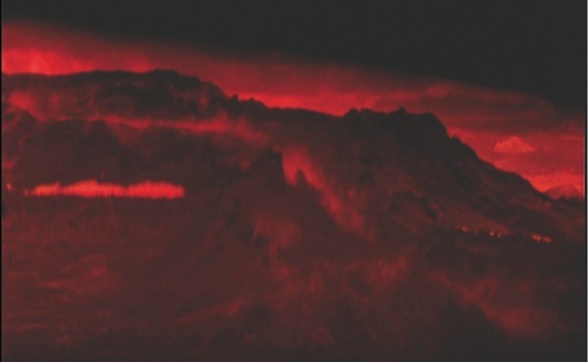| M | T | W | T | F | S | S |
|---|---|---|---|---|---|---|
| 1 | 2 | 3 | 4 | 5 | 6 | 7 |
| 8 | 9 | 10 | 11 | 12 | 13 | 14 |
| 15 | 16 | 17 | 18 | 19 | 20 | 21 |
| 22 | 23 | 24 | 25 | 26 | 27 | 28 |
| 29 | 30 | 31 | ||||
Glass hour is the third part in Clare Langan’s post-apocalyptic trilogy that commenced with Forty Below in 1999 and continued with Too dark for night in 2001. The three films will be shown together for the first time in the International 2002. Having explored the natural wastelands of the Namibian desert and the landscapes of Iceland and Ireland, Glass hour adds a third dimension to Langan’s exploration ‘of mankind’s brief fragile existence in the face of apparently limitless forces of nature’. Set in deserted urban and industrial wastelands, Glass hour shifts the focus from the natural to the manmade environment. Glass hour explicitly depicts the impact of monumental devastation on the human habitat while, at the same time, posing the question as to how much this grim fate might be self-inflicted. Massive factories, smoking chimneys and bland industrial sheds are seen in dreamlike sequences, ambiguously positioned between the indifferent chronicling of terminal decline due to some global disaster and a defiant celebration of the enduring technological sublime. The monuments to mankind’s incessant urge to build, create, produce and multiply still stand tall and bask in the steely cold light of an eternal winter of discontent. Human hubris, however, is challenged by a force even greater than global capitalism: the earth opens up, boiling in volcanic anger, ready to swallow whole cities, to cover its nondescript sprawling suburbs with black ash and penetrate industrial estates with toxic fumes. In all three films, Langan has experimented with handmade filters painted with glass paint that are placed in front of or inside the lens. This simple procedure results in stunning scenes of great immediacy, supported by pervasive soundscapes that intensify the dreamlike atmosphere of the installations. There is nothing more beautiful than a disaster on a monumental scale, when the grandeur of nature and the frisson of death observed from afar coincide in a panoramic catastrophe, arrested in time for our viewing pleasure. Langan refrains from the spectacular fireworks of hurricanes, volcanic eruptions, earthquakes or deluges, and instead records the gradual progress of destruction and nature’s reconstruction through its extreme states. Her land and cityscapes are largely unpopulated locations – with only a few reminders of human existence – that have remained strangely intact, as if preserved in some kind of Pompeian deep storage. The catastrophe has already happened and we are confronted with an apocalyptic aftermath as the earth pushes back the boundaries of human civilisation. Nature itself knows no destruction but only an endless cycle of growth and decay. Despite the gloomy, turbulent mood of eternal change that permeates these film installations, there is also serenity and peacefulness as nature asserts its rightful place. Langan’s trilogy ultimately projects not a dystopian view of the end of the human race through self-annihilation but the beginning of a process of regeneration and rebirth. Christoph Grunenberg
Project Credits Courtesy the artist With support from: Cultural Relations Committee, Department of Arts, Heritage, Gaeltacht & The Islands, Ireland; The Elephant Trust. Forty Below is funded by The Arts Council of Ireland/An Chomhairle Ealaion. Too dark for night and Glass hour are funded by The Arts Council of Ireland/An Chomhairle Ealaion and The Irish Film/Bord Scannan na hEirrann. Forty Below Production: Cinematography: Clare Langan, Robbie Ryan; Performer: Tristan Gribbin; Composer: Pol Brennan; Editor: Isobel Stephenson. Too dark for night Production: Cinematogography: Clare Langan, Robbie Ryan; Producer: Melanie Gore Grimes; Performer: Wendy Judge; Composer: Niall Byrne; Voice: Katell Keineg; Editor: Isobel Stephenson. Glass hour Production: Cinematography: Clare Langan, Robbie Ryan; Producer: Melanie Gore Grimes; Performer: Anna Rackard; Composer: Niall Byrne; Voice: Katell Keineg; Editor: Isobel Stephenson. All three films: Camera Equipment: Panavision Ireland; Surround Sound Mix: Aidan Foley, Masterlabs Post; Post Production: Screen Scene; DVD Authoring: DV4. The artist would like to thank: Siobhan Bourke, Seamus Byrne, Aileen Corkery, Jim Duggan, Pinky Ghundale, Sarah Glennie, Kevin Green, Green on Red Gallery, Keith Griffiths, Jenny Haughton, Irish Museum of Modern Art, Labrador Films, Brendan McCarthy, Patrick T. Murphy, Namib Film Services, Nomad Films, Panasonic, Tony Podesta, Rod Stoneman, Team Effects
Liverpool Biennial
55 New Bird Street
Liverpool L1 0BW
- T +44 (0)151 709 7444
- info@biennial.com
Liverpool Biennial is funded by
Founding Supporter
James Moores
